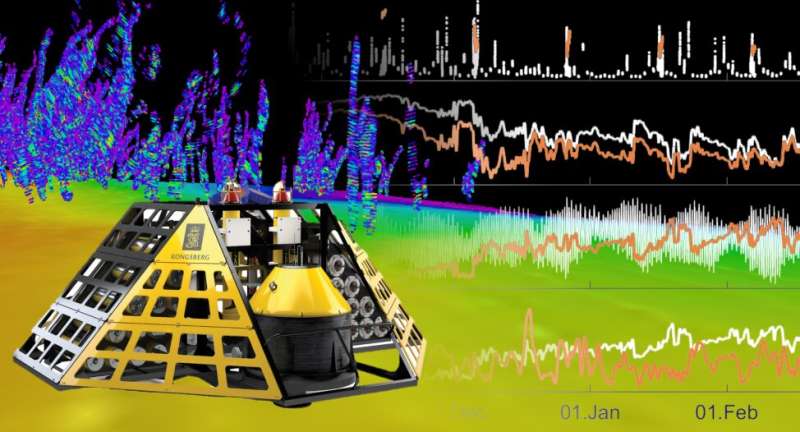New state-of-the-art technology collects a unique time series from methane seeps in the Arctic

A new study published in Ocean Science conducted by CAGE Ph.D. candidate Knut Ola Dølven and co-authors presents time-series data from two methane seep sites offshore western Svalbard, in the Arctic. These unique results show high variability both on hourly and seasonal time-scales and describe the interconnectivity between methane seepage and the ocean.
“The length and location are what makes these time-series unique, as they answer old and raise new questions related to this variability and how we can better constrain it in future emission estimates.” Says Knut Ola Dølven, Dølven, who conducted this study as part of his Ph.D. at CAGE.
Areas of intense methane seepage
In 2015 and 2016, two K-Lander observatories were deployed over distinct intensive methane seepage sites west of Prins Karls Forland, where thousands of gas bubble streams originating from the seafloor were observed.
Despite the knowledge that methane seep sites likely experience high temporal and spatial variability, our understanding of the amount, distribution, and release of methane in the Arctic Ocean has largely relied on studies that were undertaken in the late spring to early autumn due to better ice and weather conditions. Until now.
Long term, continuous monitoring of methane release
Using data from the K-Lander, Dølven and co-authors processed a unique long time-series that spanned 10 months, measuring methane, carbon dioxide and physical parameters at each site. These measurements provided important insights into the short-term and seasonal variations of methane emissions and concentrations.
“It was interesting to observe that, despite the very high short-term variability in methane release, the source of methane emission seemed to be relatively unchanged throughout the 10-month deployment. This has strong implications on future interpretations of methane concentration in seep areas.” Says Dølven.
There is also increased potential for methane release to the atmosphere during the fall and winter, if seepage persists, due to the weaker water column stratification (increased mixing of the layers in the ocean).
While seabed seepage is considered a minor natural source of atmospheric methane, there are large uncertainties related to the current and predicted emission estimates. Dølven and co-authors were, therefore, able to highlight and constrain uncertainties related to variability in methane inventory estimates from seabed methane seepage.
K-Lander technology in future research applications
This work highlighted the successful cooperation between maritime industry and research teams, providing cutting edge technology for monitoring methane to help explain questions on oceanic greenhouse gas emissions. This is the first long term data series providing exceptional multi-sensor data on methane release and other ocean physical and chemical conditions in the Arctic.
“This infrastructure will play a major role in understanding factors controlling methane emissions not only in Arctic, as highlighted in this study, but in other locations worldwide as well. Methane seepage data in combination with other parameters measured by the K-Lander will help in estimating present and future global methane budgets in our oceans” says Bénédicte Ferré, the team leader for WP4 ‘Gas in the Water Column’ and EMAN7, and the responsible for the development, acquisition and data analysis related to the K-Lander.
Methane observatories successfully deployed in the Arctic
Knut Ola Dølven et al, Autonomous methane seep site monitoring offshore western Svalbard: hourly to seasonal variability and associated oceanographic parameters, Ocean Science (2022). DOI: 10.5194/os-18-233-2022
Provided by
UiT The Arctic University of Norway
Citation:
New state-of-the-art technology collects a unique time series from methane seeps in the Arctic (2022, February 25)
retrieved 25 February 2022
from https://phys.org/news/2022-02-state-of-the-art-technology-unique-series-methane.html
This document is subject to copyright. Apart from any fair dealing for the purpose of private study or research, no
part may be reproduced without the written permission. The content is provided for information purposes only.
For all the latest Science News Click Here
For the latest news and updates, follow us on Google News.

